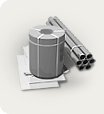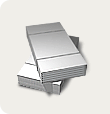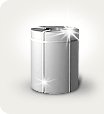The first prototype cnc machines can be - with a big stretch - to call the "Antikythera mechanism" - a mysterious mechanical device raised from the bottom of the sea in 1901 near Antikythera Island (hence the name). According to modern scientists, it served astronomical purposes.
Ancient Greeks and ancient CNC
The Greeks, as you know, were quite lazy guys - in general, they did not like to work, except for feasts, wars and philosophizing as work. Therefore, the development of mechanical devices stalled until the Late Middle Ages, when the development of metallurgy and the need for simple mechanization gave impetus to the development of engineering. Something was among the Byzantines, something among the Arabs - but only a few copies have survived only in legends.
Dad, what is this? This is a music box!
Actually, a "software" device of the next generation can be safely called a music box (as well as its variants in the form of a barrel organ and other, in general, non-production devices). But the idea behind the barrel organ - programming tool management - generally fits the definition of CNC (although, of course, it wasn’t numeric yet).
In addition, it was important that one and the same device could be "re-programmed" to play different melodies: it was enough to rearrange the pins on the program drum (or replace the entire drum).
Later, a prototype of punched tape appeared - first metal, then paper - but all these methods were united by several significant drawbacks:
- the complexity of programming: breaking a melody (or other process) into its components, decomposing it into pins-holes, achieving the coherence of all the details was only possible for very experienced craftsmen;
- "Software media" wear. Any mechanical interaction leads to wear of the components, which means that it was necessary to constantly update the structure, change parts, lubricate, remove rust, breakages ...
- low "read" speed. Already when the first real computers appeared, the bottleneck in performance was not the processor speed or the amount of memory, but the limited speed of reading from the media. However, this is still a significant problem now;
- the complexity (or even impossibility) of making changes to the program: in order to fix, say, a "line of program code", it was necessary to rebuild the entire program from the beginning. And this limitation is both in terms of the complexity of programmed actions - it is more difficult with long programs - and inflexibility, limited to only a few templates.
Numerical Programs
Everything, of course, has changed with the advent of digital (now truly numeric) devices: now reading takes place instantly, and the "number" has no wear, and making changes to the program has become much easier. And now cnc machine is available not only for large productions, but also for hobbies on the desktop in a small home workshop.






